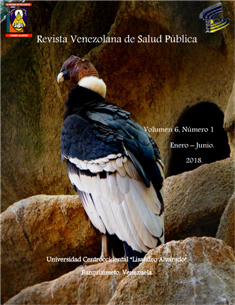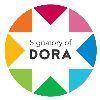Capital social y estilos de vida: una revisión de la literatura
Palabras clave:
capital social, estilos de vida, promoción de la saludResumen
En la actualidad diferentes estudios sugieren que el capital social es un determinante clave de la salud física y psicológica en la población; sin embargo poco se sabe acerca de la relación entre éste y las conductas asociadas a los estilos de vida. El presente estudio tiene como objetivo identificar las evidencias empíricas que evalúan la relación entre el capital social y las conductas asociadas a los estilos de vida mediante una revisión de la literatura. Se examinaron fuentes originales en inglés, español y portugués de las bases de datos: Pubmed, Scielo, Ebsco, Google Scholar y Sciencedirect entre los años 2000 y 2017; utilizando los siguientes descriptores: capital social, estilos de vida, conductas de salud. La muestra final quedó conformada por treinta y seis (36) artículos. Los hallazgos evidencian que el capital social se relaciona con todos los factores asociados a los estilos de vida en mayor o menor magnitud.Los estudios sustentan la idea de que la participación social, las redes sociales de apoyo, la confianza social y la membresía como elementos del capital social, poseen una influencia notable sobre los estilos de vida, de allí su importancia de incorporarlo en futuros programas e intervenciones de promoción de la salud.
Descargas
Citas
2. Bourdieu P, Wacquant L. An invitation to reflexive sociology. Chicago: University of Chicago press; 1992.
3. Coleman J. Foundations of Social Theory. Cambridge (Massachusetts): Belknap Press of Harvard University Press; 1990.
4. Putnam R. The Prosperous Community: Social Capital and Public Life. American Prospect 1993; 13: 35-42.
5. Islam MK, Merlo J, Kawachi I, Lindstrom M, Gerdtham UG. Social capital and health: does egalitarianism matter? A literature review. International Journal for Equity in Health 2006; 5 (3).
6. Colletta NJ, Cullen ML. The nexus between violent conflict, social capital and social cohesion: lessons from Cambodia, Rwanda, Guatemala, and Somalia. Washington, EEUU: The World Bank; 2000.
7. Kripper CE, Sapag JC. Capital social y salud en América Latina y el Caribe: una revisión sistemática. Rev Panam Salud Pública 2009; 25:162-170.
8. Loch M, Tanno R, Eumann A, Martinez D, Rodríguez F. Relationship between social capital indicators and lifestyle in Brazilian adults. Cad. Saúde Pública 2015; 31(8):1636-1647.
9. Islam S, Alam M. Social capital and mental health: results from a cross-sectional study in Bangladesh. Asian Social Science 2014; 10 (2): 118-125.
10. Alvarado R, Sapag J, Arellano J, Alarcón A, Tapia E. Capital social y salud mental en una muestra representativa de trabajadores chilenos. Revista de la Facultad de Ciencias Médicas 2015; 73(3): 227-235.
11. Fujiwara T, Kawachi I. Social capital and health a study of adult twins in the U.S. Am J Prev Med 2008; 35(2): 139-144.
12. Rocco L, Fumagalli E, Suhrcke M. From social capital to health and back. Health Eco 2014; 23: 586–605.
13. Cullen M, Whiteford H. The interrelations of social capital with health and mental health: discussion paper. Canberra: Commonwealth of Australia; 2001.
14. Hamano T, Fujisawa Y, Ishida Y, Subramanian SV, Kawachi I, Shiwaku K. Social capital and mental health in Japan: a multilevel analysis. PLoS ONE 2010; 5 (10): e13214.
15. Pinxten W, Lievens J. The importance of economic, social and cultural capital in understanding health inequalities: using a Bourdieu based approach in research on physical and mental health perceptions. Sociology of Health & Illness. 2014; xx (xx): 1–15.
16. Yip W, Subramanian SV, Mitchell AD, Lee DTS, Wang J, Kawachi I. Does social capital enhance health and well-being? Evidence from rural China. Soc Sci Med 2007; 64:35–49.
17. Contoyannis P, Jones AM. Socio-economic status, health and lifestyle. J Health Eco 2004; 23: 965–995.
18. Marmot M, Wilkinson RG. Social determinants of health. 2da. ed. Oxford: Oxford University Press; 2006.
19. Kantomaa M, Tammelin T, Ebeling H, Stamatakis E, Taanila A. High levels of physical activity and cardiorespiratory fitness are associated with good self-rated health in adolescents. Journal of Physical Activity and Health 2015; 12 (2): 266-272.
20. Doll R, Peto R, Boreham J, Sutherland I. Mortality in relation to smoking: 50 years’ observations on male British doctors. BMJ 2004; 328: 1519.
21. Kaleta D, Makowiec T, Dziankowska E, Jegier A. Physical activity and self-perceived health status. Int J Occup Med Environ Health 2006; 19 (1): 61-69.
22. Lindstrom M, Hanson BS, Ostergren PO, Berglund G. Socioeconomic differences in smoking cessation: the role of social participation. Scand J Public Health 2000; 28: 200-8.
23. Lindstrom M, Hanson BS, Wirfalt E, Ostergren PO. Socioeconomic differences in the consumption of vegetables, fruit and fruit juices. The influence of psychosocial factors. Eur J Public Health 2001; 11: 51–59.
24. Lindstrom M, Isacsson SO. Smoking cessation among daily smokers, aged 45–69 years: a longitudinal study in Malmo, Sweden. Addiction 2002; 97:205–215.
25. Crosby R, Holtgrave D, DiClemente R, Wingood G, Gayle J. Social Capital as a Predictor of Adolescents’ Sexual Risk Behavior: A State-Level Exploratory Study. AIDS and Behavior 2003; 7 (3): 245-252.
26. Lindström, M. Social capital and the miniaturization of community among daily and intermittent smokers: a population-based study. Prev Med 2003; 36 (2): 177–184.
27. Lindström M, Isacsson S, Elmståhl S, The Malmö Shoulder-Neck Study Group. Impact of different aspects of social participation and social capital on smoking cessation among daily smokers: a longitudinal study. Tobacco Control 2003; 12: 274–281.
28. Lindström M, Moghaddassi M, Bolin K, Lindgren B, Merlo J. Social participation, social capital and daily tobacco smoking: a population-based multilevel analysis in Malmo, Sweden. Scand J Public Health 2003; 31: 444–450.
29. Lindström M. Psychosocial work conditions, social capital, and daily smoking: a population based study. Tobacco Control 2004; 13:289–295.
30. Xue X, Cheng M. Social capital and health in China: exploring the mediating role of lifestyle. BMC Public Health 2017; 17:863.
31. Poortinga W. Do health behaviors mediate the association between social capital and health? Prev Med 2006; 43: 488-493.
32. Pattussi MP, Hardy R, Sheiham A. Neighborhood social capital and dental injuries in Brazilian adolescents. Am J Public Health. 2006; 96:1462–1468.
33. Pattussi MP, Hardy R, Sheiham A. The potential impact of neighborhood empowerment on dental caries among adolescents. Community Dent Oral Epidemiol 2006; 34:344–350.
34. Sorensen G, Stoddard A, Dubowitz T, Barbeau E, Bigby J, Emmons K, Berkman L, Peterson K. The influence of social context on changes in fruit and vegetable consumption: results of the healthy directions studies. Am J Public Health 2007; 97 (7): 1216-1227.
35. Sapag J, Poblete F, Eicher C, Aracena M, Caneo C, Vera G, Martínez M, Hoyos R, Villarroel L, Bradford E. Tobacco smoking in urban neighborhoods: Exploring social capital as a protective factor in Santiago, Chile. Nicotine & Tobacco Research 2010; 12 (9): 927–936.
36. Aida J, Hanibuchi T, Nakade M, Hirai H, Osaka K, Kondo K. The different effects of vertical social capital and horizontal social capital on dental status: a multilevel analysis. Social Science & Medicine 2009; 69(4): 512e518.
37. Agardh A, Emmelin M, Muriisa R, Ostergren P. Social capital and sexual behavior among Ugandan university students. Global Health Action 2010; 3: 5432.
38. Aida J, Kondo K, Kondo N, Watt R, Sheiham A, Tsakos G. Income inequality, social capital and self-rated health and dental status in older Japanese. Social Science & Medicine 2011; 73: 1561 – 1568.
39. Aida J, Kuriyama S, Ohmori-Matsuda K, Hozawa A, Osaka K, Tsuji I. The association between neighborhood social capital and self-reported dentate status in elderly Japanese - The Ohsaki Cohort 2006 Study. Community Dent Oral Epidemiol 2011; 39:239–249.
40. Giordano GN, Lindström M. The impact of social capital on changes in smoking behaviour: a longitudinal cohort study. Eur J Public Health 2011; 21 (3): 347-354.
41. Nagaoka K, Fujiwara T, Ito J. Do income inequality and social capital associate with measles-containing vaccine coverage rate? Vaccine 2012; 30: 7481– 7488.
42. Furuta M, Ekuni D, Takao S, Suzuki E, Morita M, Kawachi I. Social capital and self-rated oral health among young people. Community Dent Oral Epidemiol 2012; 40: 97–104.
43. Jung M, Lina L, Viswanath K. Associations between health communication behaviors, neighborhood social capital, vaccine knowledge, and parents’ H1N1 vaccination of their children. Vaccine 2013; 31: 4860 – 4866.
44. Marques B, Gondim A, Vianna M. Social capital and dental pain in Brazilian northeast: a multilevel cross-sectional study. BMC Oral Health 2013; 13 (2):1-9.
45. Åslund C, Nilsson K. Social capital in relation to alcohol consumption, smoking, and illicit drug use among adolescents: a cross-sectional study in Sweden. International Journal for Equity in Health 2013; 12:33.
46. Nieminen T, Prättälä R, Martelin T, Härkänen T, Hyyppä M, Alanen E, Koskinen S. Social capital, health behaviours and health: a population-based associational study. BMC Public Health 2013; 13: 613.
47. Rönnerstrand B. Social capital and immunization against the 2009 A (H1N1) pandemic in Sweden. Scandinavian Journal of Public Health 2013; 41: 853–859.
48. Amin I. Social capital and sexual risk-taking behaviors among older adults in the United States. Journal of Applied Gerontology 2014; 1-18.
49. Lindström, M, Axelsson J, Modén B, Rosvall M. Sexual orientation, social capital and daily tobacco smoking: a population-based study. BMC Public Health 2014; 14: 565.
50. Chun-Yuan C, Chi-Chen W, Hsing-Yi C, Lee-Lan Y. The effects of social structure and social capital on changes in smoking status from 8th to 9th grade: Results of the Child and Adolescent Behaviors in Long-term Evolution (CABLE) study. Prev Med 2014; 62: 148-154.
51. Rönnerstrand B. Social capital and immunization against the 2009 A (H1N1) pandemic in the American States. Public Health 2014; 128: 709e715.
52. Nagy E, Moore S, Gruber R, Paquet C, Arora N, Dubé L. Parental social capital and children's sleep disturbances. Sleep Health 2016; 2: 330–334.
53. Odimegwu C, De Wet N, Dolapo O. Perceptions of social capital and sexual behaviour among youth in South Africa, Journal of Child & Adolescent Mental Health 2017; 29 (3): 205-217.
54. Johnson C, Sharkey J, Dean W. Eating behaviors and social capital are associated with fruit and vegetable intake among rural adults. J Hunger Environ Nutr 2010; 5(3): 302–315.
55. Motohashi K, Kaneko Y, Fujita K, Motohashi Y, Nakamura A. Interest in dietary pattern, social capital, and psychological distress: a cross-sectional study in a rural Japanese community. BMC Public Health 2013; 13: 933.
56. Lindström M, Hanson BS, Östergren PO. Socioeconomic differences in leisure time physical activity: the role of shaping participation and social capital in shaping health related behaviour. Soc Sci Med 2001; 52 (3): 441–451.
57. Kawachi I, Subramanian SV, Kim D. Social capital and health. New York (NY): Springer; 2008.
58. Suzuki E, Yamamoto E, Takao S, Kawachi I, Subramanian S. Clarifying the use of aggregated exposures in multilevel models: self-included vs. self-excluded measures. PLoS ONE 2012; 7(12): e51717.
Publicado
Cómo citar
Número
Sección
Derechos del/de autor/es a partir del año de publicación
Esta obra está bajo la licencia:
Creative Commons Reconocimiento-NoComercial-CompartirIgual 4.0 Internacional (CC BY-NC-SA 4.0)
Las opiniones expresadas por los autores no necesariamente reflejan la postura del editor de la publicación ni de la UCLA. Se autoriza la reproducción total o parcial de los textos aquí publicados, siempre y cuando se cite la fuente completa y la dirección electrónica de esta revista. Los autores(as) tienen el derecho de utilizar sus artículos para cualquier propósito siempre y cuando se realice sin fines de lucro. Los autores(as) pueden publicar en internet o cualquier otro medio la versión final aprobada de su trabajo, luego que esta ha sido publicada en esta revista.






